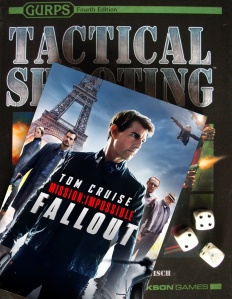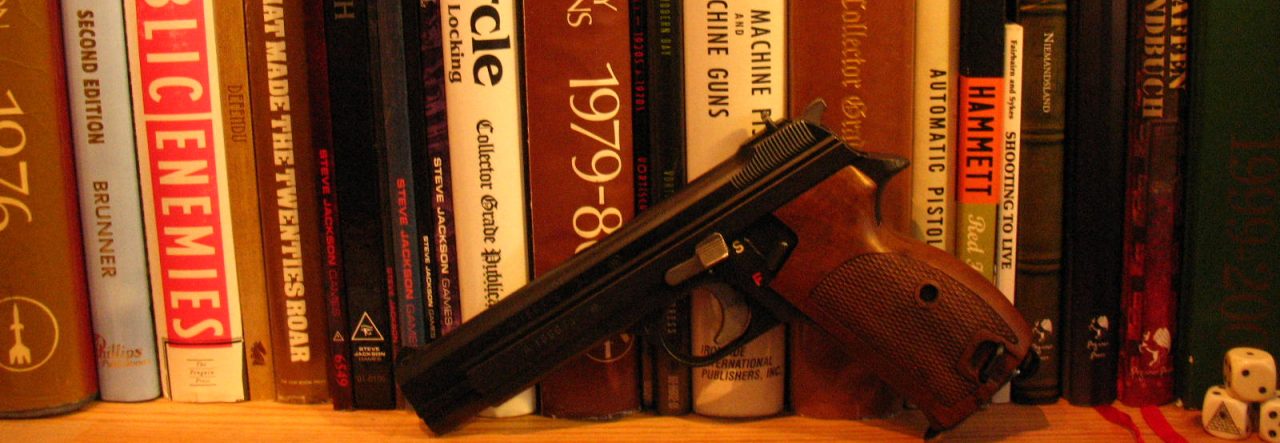Christopher McQuarrie’s Mission: Impossible ‒ Fallout (2018) is the latest instalment in the somewhat tired but still fun Mission: Impossible franchise. The highly cinematic films are prime examples for GURPS Action scenarios. Nevertheless much of the shooting is actually reasonably realistic. I take a look at a short scene in which IMF Agent Ethan Hunt (Tom Cruise) shows off his gunfighting skills, and analyze how it would play out in GURPS terms, specifically using GURPS Tactical Shooting.

Watch just the scene here (the action starts at 00:35). Stop reading if you want to avoid SPOILERS.
Round per Round
Prelude: IMF Agent Ethan Hunt is a shooter (GURPS Action 1: Heroes, p. 14) proficient in the Modern Pistol shooting style (Tactical Shooting, pp. 48-49). Four henchmen of the White Widow have cornered Hunt and his team at the Square de l’Alboni in Paris, France. Henchman #1 has just shot down a Gardienne de la Paix of the Préfecture de Police de Paris and Henchman #2 walks over to kill her. Henchman #1, Henchman #3, and Henchman #4 remain in position. All five are in Triggered mode (Tactical Shooting, p. 34). Hunt has his H&K USP Compact pistol in 9×19mm Parabellum (GURPS High-Tech, p. 102) ‒ undoubtedly loaded with hollow-points (High-Tech, pp. 166-167, and Tactical Shooting, p. 78) ‒ still in his waistband in the hip position; it’s unclear whether he is wearing an inside-the-waistband holster or simply stuffed it behind the belt. Henchman #2 holds a SIG-Sauer P226 pistol (High-Tech, p. 102) in his right hand. Henchman #1 holds a Glock 17 pistol (High-Tech, p. 102) in a two-handed grip in a Low Ready Position. Henchman #3 has stuck his pistol into his waistband in the appendix position and has his right hand on its butt. Henchman #4 holds his pistol in a one-handed grip in Sul Position. All four Henchmen stand about 3 m away from Hunt.
1st Second: While three of the Henchmen have ready firearms, Hunt and Henchman #3 are unready. This requires a Quick Contest between the former’s Guns and the latter’s Fast-Draw (Tactical Shooting, p. 10). Henchman #1 gets +4 to his Guns (Pistol) roll since he already has it in his hands but -1 since he is using a two-handed grip for a total of +3 to Guns (Pistol). Henchman #2 does not get to roll ‒ he is preoccupied with the police officer and has turned his back to the others. Henchman #3 gets -10 to Fast-Draw (Pistol). Henchman #4 gets +4 to his Guns (Pistol) roll since he already has it in his hand. Hunt gets -10 to Fast-Draw (Pistol), modified with +1 for Combat Reflexes, +2 for hip-shooting (Tactical Shooting, p. 11), and -1 for under jacket carry (Tactical Shooting, p. 42), for a total of -8 to Fast-Draw (Pistol). Hunt wins the Quick Contest and gets to shoot first. Since the USP Compact has a double-action trigger (High-Tech, p. 82) and is in Condition Two (Tactical Shooting, p. 8), he doesn’t need to do anything else to ready it. Hunt then takes an Attack manoeuvre and fires one unsighted (Tactical Shooting, p. 13) hip-shot (Tactical Shooting, p. 11) at the back of Henchman #2; -1 (range) -3 (vitals hit location) = -4 to Guns (Pistol). Hunt probably has the Targeted Attack (Pistol/Vitals) technique (Tactical Shooting, p. 45) to reduce the penalty from -3 to -1, for a total of -2 to Guns (Pistol). He makes his attack roll. Henchman #2 gets no Dodge roll since he is unaware of the attack. He is hit in the vitals for three times 2d+1 pi+ (average 24 damage points). Henchman #2 is at -1×HP or less and needs to make an immediate HT roll to avoid death (p. B419) and because of the major wound to the vitals an immediate HT-5 roll to avoid knockdown and possibly unconsciousness (p. B420). He fails one or both of these rolls and is down. Henchman #1 takes an All-Out-Attack (Determined) manoeuvre (p. B324) and fires one two-handed sighted (Tactical Shooting, p. 13) shot at Hunt; his Glock 17 is in Condition Zero (Tactical Shooting, p. 8): +1 (All-Out Attack (Determined)) -1 (range) = +0 to Guns (Pistol). He fails his attack roll and misses [The edit makes this shot appear later in the 3rd Second at around 00:37.99, but that makes no sense realistically or game-mechanically]. Henchman #3 takes a Ready manoeuvre and starts drawing his pistol. Henchman #4 takes a Ready manoeuvre and raises his pistol to a one-handed stance for a sighted shot [Per the rules, this takes no time, but that is an oversimplification.]
2nd Second: Hunt now grips his pistol with both hands and changes to a more aggressive and stable Isoceles shooting stance (Tactical Shooting, pp. 11-12). This would ordinarily require a Ready manoeuvre, but Hunt has the Grip Mastery (Pistol) perk (Tactical Shooting, p. 39), which allows him to do this as a free action. He then takes an All-Out-Attack (Determined) manoeuvre, swivelling about 45° to his left front facing (p. B385) and taking one two-handed sighted shot at Henchman #1; +1 (All-Out Attack (Determined)) -1 (range) -3 (vitals hit location) = -3 to Guns (Pistol). The Targeted Attack (Pistol/Vitals) technique reduces this to -1 to Guns (Pistol). He makes his attack roll. Henchman #1 cannot Dodge since he has made an All-Out Attack (Determined) last turn (p. B324). He is hit in the vitals for three times 2d+1 pi+ (average 24 damage points). Henchman #1 is at -1×HP or less and needs to make an immediate HT roll to avoid death and because of the major wound to the vitals an immediate HT-5 roll to avoid knockdown and possibly unconsciousness. He fails one or both of these rolls and is down. Henchman #4 takes an All-Out Attack (Determined) manoeuvre and fires one sighted (Tactical Shooting, p. 13) one-handed shot at Hunt; his SIG-Sauer P226 is in Condition Two and has a double-action trigger: +1 (All-Out Attack (Determined)) -1 (range) = +0 to Guns (Pistol). He fails his attack roll and misses. [The edit makes this shot appear later in the 3rd Second at around 00:38.24, but that makes no sense realistically or game-mechanically].
3rd Second: Hunt makes a Ranged Rapid Strike (Tactical Shooting, p. 18) with two All-Out Attack (Determined) manoeuvres using two two-handed sighted shots (Tactical Shooting, p. 13) at Henchman #3 and Henchman #4; +1 (All-Out Attack (Determined)) -6 (Ranged Rapid Strike) -1 (range) -3 (vitals hit location) = -9 to Guns (Pistol). The smooth execution of the shots suggests that Hunt has the Quick Shot (Pistol) technique (Tactical Shooting, p. 45) to buy off the -6 penalty, for a total of -3 to Guns (Pistol), or -1 to Guns (Pistol) with the Targeted Attack (Pistol/Vitals) technique. He makes both attack rolls. Henchman #3 fails his Dodge roll. He is hit in the vitals for three times 2d+1 pi+ (average 24 damage points). Henchman #3 is at -1×HP or less and needs to make an immediate HT roll to avoid death and because of the major wound to the vitals an immediate HT-5 roll to avoid knockdown and possibly unconsciousness. He fails one or both of these rolls and is down. Henchman #4 cannot Dodge since he has made an All-Out Attack (Determined) last turn. He is hit in the vitals for three times 2d+1 pi+ (average 24 damage points). Henchman #4 is at -1×HP or less and needs to make an immediate HT roll to avoid death and because of the major wound to the vitals an immediate HT-5 roll to avoid knockdown and possibly unconsciousness. He fails one or both of these rolls and is down.
4th Second: Spent 9×19mm cases tinkle on the ground. IMF Agent Benji Dunn stands with his mouth open. CIA Agent August Walker grudgingly nods in appreciation of Hunt’s performance.
Results
Hunt takes down four opponents with four shots in three turns, from an unreadied position. The time elapsed between the first and the fourth shot is just 1.8 seconds, a perfect score by anyone’s reckoning.
Note how Hunt shoots Henchman #2 and Henchman #1 in the order of their dangerousness (to the innocent police officer respectively himself), but then simply continues to go right to left despite Henchman #4 being more dangerous than Henchman #3 on account of having a ready firearm. It is faster to continue moving in one direction than to readjust and then come back; this, of course, cannot be modelled in the game, but it is the kind of thing a gun-savvy player might have his character do.
Hunt needs rather high Fast-Draw (Pistol) skill to confidently and reliably succeed in this scene. This sounds right, considering how fast Tom Cruise draws on film.
The edit of the scene shows Hunt first from the front and then from behind; the switching angles are the reason that the shots of Henchman #1 and Henchman #4 appear slightly delayed.
